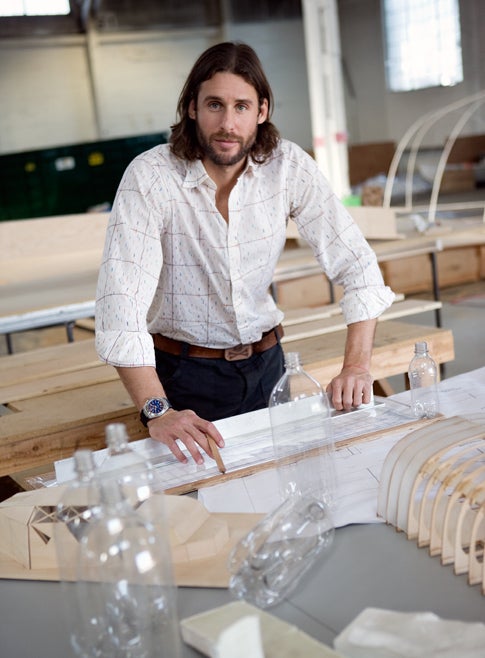Message In A Bottle
Explorer David de Rothschild promotes ocean cleanup on a plastic-bottle raft

Given the choice, you probably wouldn’t risk sailing 11,500 miles from San Francisco to Sydney in a boat handmade of 20,000 plastic water bottles. But David de Rothschild, the founder of the nonprofit educational organization Adventure Ecology, sees such a vessel as the perfect way to “beat waste” by promoting new uses for recycled plastic while dramatizing the problem of ocean debris. Next month, de Rothschild and a crew of scientists will sail the Plastiki, a 60-foot catamaran, to environmental hotspots including Bikini Atoll, the former atomic-bomb testing site, and Tuvalu, an island rapidly disappearing under rising seas.
He will also swing by the northern reaches of the Great Pacific Garbage Patch, the Canada-size, 100-million-ton accumulation of mostly plastic refuse trapped in a vortex of ocean currents in the middle of the Pacific. This toxic stew, made up of everything from decomposing Lego blocks to supermarket bags, kills more than a million seabirds and 100,000 mammals a year. We talked to de Rothschild about coming face-to-face with the refuse and his plan to help clean it up.
Q: How bad is plastic pollution in the oceans?
A: The National Academy of Sciences estimates that five million tons of plastic enter the ocean each year. Some large pieces float on the surface; plankton and fish ingest microscopic fragments. It concentrates wherever ocean currents converge, the most notorious of which is the Great Pacific Garbage Patch, which extends from about 500 miles west of California into the Sea of Japan. There’s also one off the western coast of Antarctica, and scientists have just found a huge patch off the coast of Chile.
Q: You’re planning a difficult journey — so why a boat made of plastic bottles?
A: We needed a pinup to draw attention to the problem, and for me the emblem of a cradle-to-grave society is the plastic water bottle. On average, people in the U.S. use 157 bottles of water every year. Most of that trash ends up in landfills and the ocean. We’re really hoping people might say, “Hey, if you can build a boat out of recycled plastic, why not a TV?” We want to inspire industry to find more-innovative ways to reuse plastic.
Q: How do you make 20,000 plastic bottles into a seaworthy boat?
A: We originally wanted to make the Plastiki entirely out of these bottles, but it kept twisting like a piece of licorice. So we built a frame by sandwiching plastic foam between “cloth” sheets made by a Danish company from recycled plastic. We injected CO2 into each bottle, sealed it, and packed it into one of two pontoons. Then we strapped each pontoon to a rigid plastic tube running the length of the hull. We’ve assembled the whole thing without glues or resins, so when the trip is over in June, we’ll be able to recycle the entire boat.
Q: Besides boats, how can we reuse plastic?
A: I came across two promising technologies while building my boat. There’s an inventor in New Zealand who has a machine that converts various types of plastic into building bricks. There’s also a Japanese company that transforms waste plastic into diesel. Tuvalu produces 450,000 pounds of plastic waste per year and imports 265,000 gallons of fuel. With a machine like this, it could cut fuel imports by 20 percent.
Q: How is your expedition going to help clean up the oceans?
A: At Adventure Ecology, we take an issue and find a hook to inspire children and adults to get directly involved. We’ll stop during our expedition to do beach cleanups and talk at schools, and post videos of our experiences on our blog, theplastiki.com. We’re also carrying four scientists from the Scripps Research Institute who will study marine debris, ocean acidification, coral bleaching, and overfishing, and publish their findings when the voyage wraps up.
Q: You’ve said you get seasick in a bathtub. How are you psyching yourself up for an 11,500-mile ocean voyage in an unproven vessel?
A: Ignorance is bliss. Of course, something sharp in the vortex could pierce the bottles and damage the pontoons. But even if we never make it past Hawaii, I feel that we’ll make a huge impact by raising awareness about plastics in the ocean and using waste as a resource.